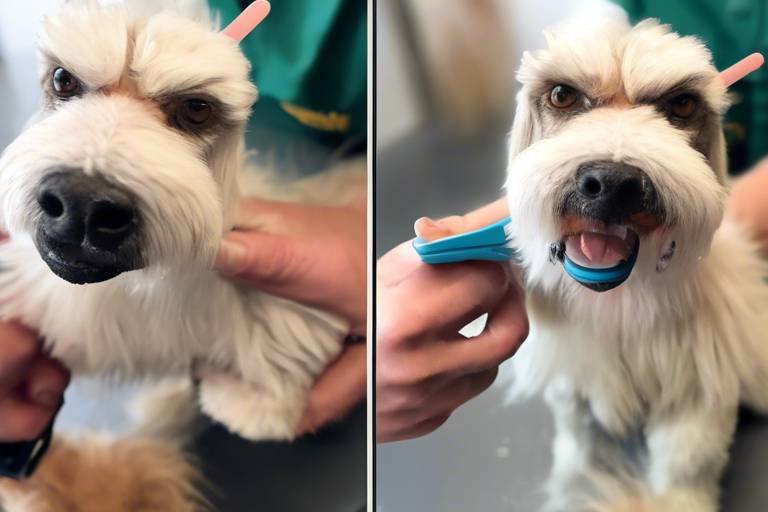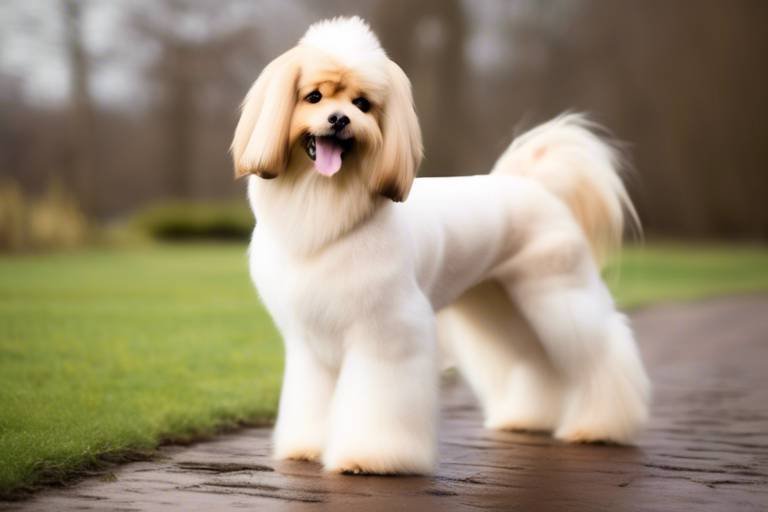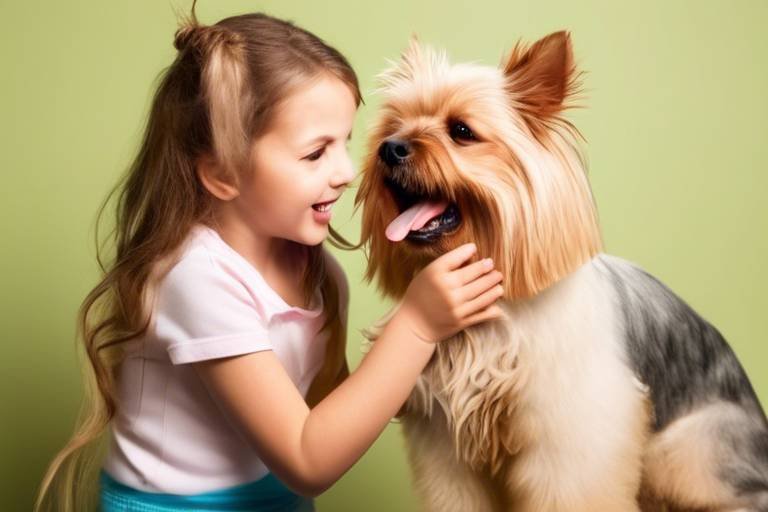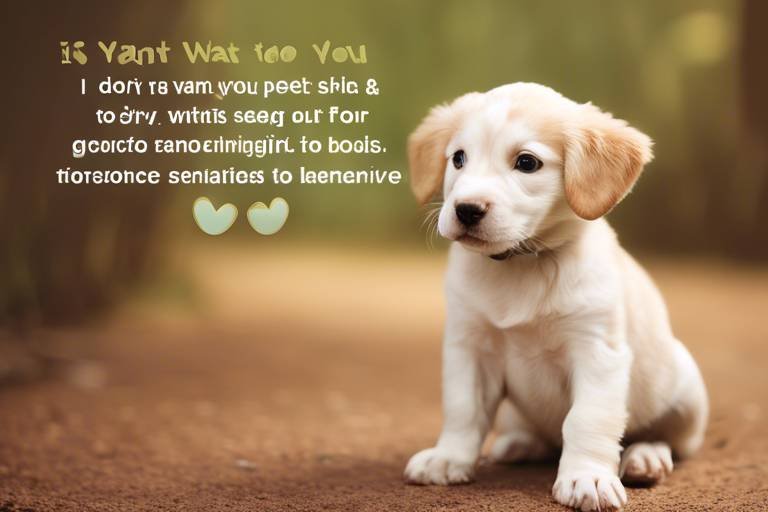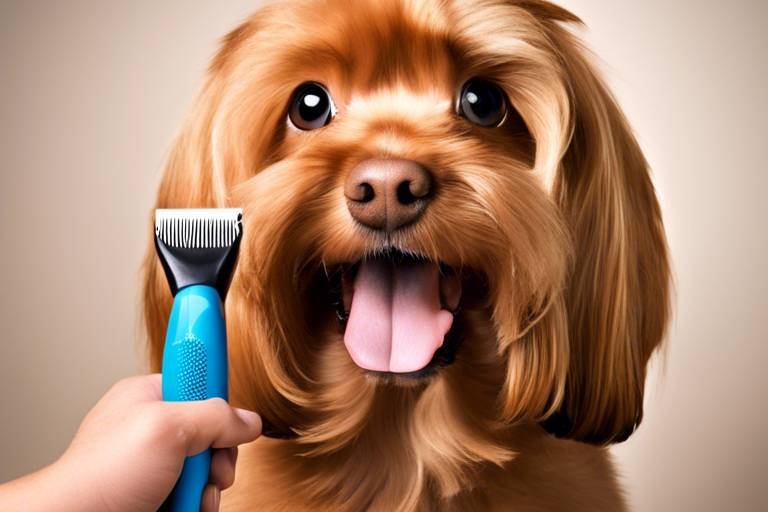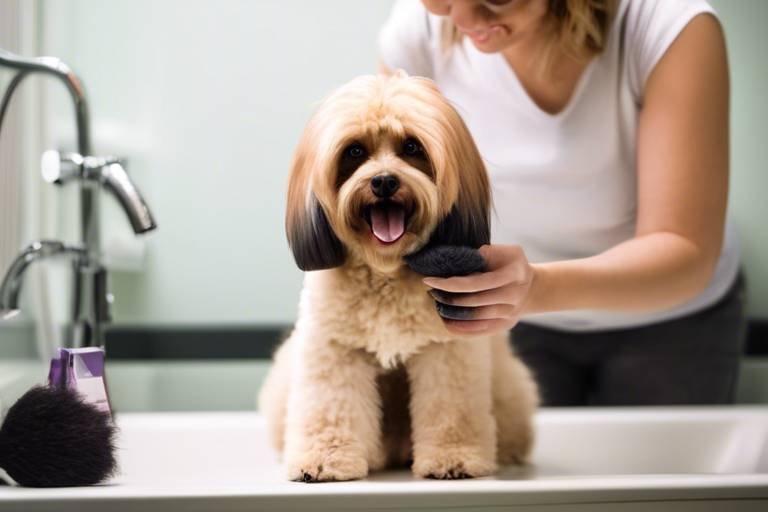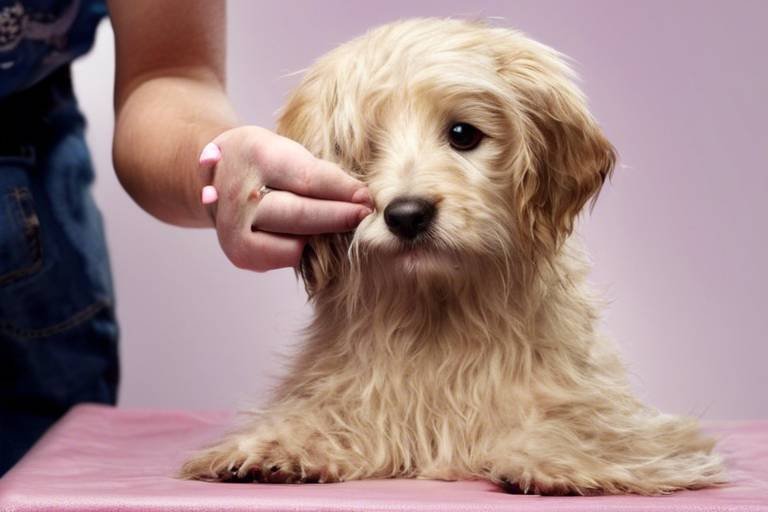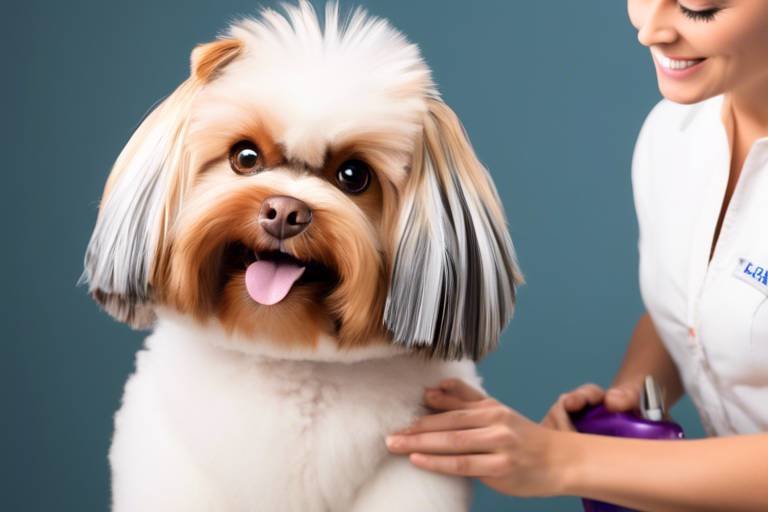The Best Grooming Practices for Rescue Pets
This article explores essential grooming techniques tailored for rescue pets, ensuring their health, comfort, and happiness. Discover practical tips and tricks to help your furry friend thrive in their new home.
Every rescue pet comes with a unique background. Understanding their specific grooming needs is crucial for their adjustment and well-being. Just like us, pets have their own stories, and some may have had rough beginnings that make them a bit more sensitive to grooming. Tailored grooming can alleviate stress and promote trust between you and your new companion. Take the time to observe how your pet reacts to different grooming tools and techniques; this will help you adjust your approach and make the experience more enjoyable for both of you.
Having the right tools is vital for effective grooming. Just imagine trying to fix your hair without a brush—frustrating, right? The same goes for your furry friend. This section highlights the must-have grooming supplies that make the process easier and more enjoyable for both you and your rescue pet. From brushes to clippers, let's dive into the essentials that will make grooming a breeze.
Different coat types require specific brushes and combs. For instance, a long-haired breed will need a slicker brush to prevent matting, while a short-haired breed may only need a rubber grooming mitt. Understanding the best options for your rescue pet's fur type is essential to prevent matting and promote a healthy coat. Regular brushing not only keeps their coat looking fabulous but also helps you bond with your pet.
De-shedding tools can significantly reduce loose fur, which is a win-win for both you and your home! Explore various de-shedding options that are effective for different breeds and coat lengths, making grooming more manageable. For example, the Furminator is a popular choice among pet owners for its efficiency in removing loose hair without damaging the undercoat.
Clippers and scissors are essential for maintaining your pet's coat. Choosing the right tools can make all the difference. Look for clippers that are quiet and have adjustable blades to cater to different fur lengths. Scissors with rounded tips are great for delicate areas. Discover how to choose the right tools to safely trim and groom your rescue pet's fur, ensuring they look their best without the stress.
Bathing is an important aspect of grooming. However, it's not just about sudsing up your pet; it's about creating a positive experience. This section covers proper bathing techniques, frequency, and suitable products to ensure a pleasant experience for your rescue pet. Use lukewarm water and a gentle, pet-safe shampoo to keep their skin healthy. Remember, too many baths can strip natural oils, so find a rhythm that works for your pet!
Healthy skin and coat are indicators of overall well-being. Learn about skin conditions common in rescue pets and how to care for their coat effectively. Regular grooming helps you spot any unusual changes in their skin or coat, such as redness or bald patches, which may indicate allergies or parasites.
Nutrition plays a key role in coat health. Just like a well-balanced diet can improve your skin, it does wonders for your pet's coat, too! Discover which dietary supplements and foods can enhance your rescue pet's skin and coat condition. Omega-3 fatty acids, for example, are fantastic for promoting a shiny coat and reducing inflammation.
Regular veterinary check-ups are essential for maintaining your pet's health. Understand the importance of routine grooming in identifying potential health issues early on. A simple grooming session can reveal lumps, bumps, or skin irritations that might need attention. So, keep that appointment with your vet!
Grooming can be stressful for some rescue pets. This section provides tips on how to create a calm and positive environment, making grooming a pleasant bonding experience. Think of grooming as a spa day for your pet—it's all about relaxation and care!
Desensitization can help anxious pets feel more comfortable during grooming. Explore effective techniques to gradually introduce grooming tools and processes to your rescue pet. Start by letting them sniff the brushes and clippers, and reward them with treats for calm behavior.
Positive reinforcement is key in training. Learn how to use treats and praise to encourage your rescue pet during grooming sessions, fostering trust and cooperation. A simple "good boy" or "good girl" can go a long way in making your pet feel secure and loved.
Different breeds have unique grooming requirements. This section outlines specific grooming practices tailored to various breeds, ensuring that all rescue pets receive the best care possible. Whether your pet is a fluffy Golden Retriever or a sleek Greyhound, each breed has its own set of grooming needs that you should be aware of.
Long-haired breeds often require more frequent grooming. Understanding the specific grooming techniques and schedules necessary to keep their coats healthy and tangle-free is crucial. Regular brushing not only prevents matting but also helps distribute natural oils, keeping their fur shiny and healthy.
Short-haired breeds may need less grooming but still require care. Discover effective grooming practices that maintain their coat and skin health without overwhelming them. A quick brush once a week can help remove dead hair and keep their skin healthy.
Grooming is an integral part of caring for rescue pets. By implementing these practices, you can enhance your pet's quality of life and strengthen your bond, ensuring a happy and healthy future together. Remember, grooming is not just a chore; it's an opportunity to connect with your furry friend!
Q: How often should I groom my rescue pet?
A: It depends on the breed and coat type. Long-haired pets may need grooming several times a week, while short-haired pets might only need it once a week.
Q: What if my pet is afraid of grooming tools?
A: Start with desensitization techniques. Introduce the tools slowly and reward them for calm behavior.
Q: Can I use human shampoo on my pet?
A: No, it's best to use pet-specific shampoos as human products can irritate their skin.

Understanding Your Rescue Pet's Needs
Every rescue pet comes with a unique background, often filled with stories that shape their behavior and grooming needs. When you welcome a rescue pet into your home, it's crucial to understand their specific grooming requirements. This understanding can significantly impact their adjustment period and overall well-being. Just like humans, pets have their own personalities and histories, and these factors can influence how they respond to grooming.
Many rescue pets may have experienced neglect or trauma, making them more sensitive to touch and handling. This is where tailored grooming practices come into play. For instance, a pet that has been previously mistreated may find grooming sessions stressful. By recognizing these signs, you can adapt your approach to make the experience less daunting. Think of it as building a bridge of trust; the more you respect their boundaries, the stronger that bond will become.
One essential aspect of understanding your rescue pet's needs is recognizing their coat type and how it affects grooming. Different breeds and mixes come with various fur types, each requiring specific care. For example:
| Coat Type | Grooming Frequency | Common Issues |
|---|---|---|
| Long-Haired | Every 2-3 days | Matting, tangles |
| Short-Haired | Weekly | Shedding, skin irritation |
| Curly | Every week | Matting, dirt buildup |
Moreover, tailored grooming can alleviate stress and promote trust between you and your new companion. It's essential to observe your pet's reactions during grooming. Are they anxious? Do they seem to enjoy certain brushes or tools more than others? Paying attention to these cues will help you create a more effective grooming routine. You might find that your rescue pet has a favorite spot that they love to be brushed, turning a chore into a delightful bonding moment.
In summary, understanding your rescue pet's needs goes beyond just the physical act of grooming. It's about developing a relationship based on trust and respect. By being patient and observant, you can create a grooming routine that not only keeps your pet looking great but also enhances their emotional well-being. Remember, every little victory in grooming is a step towards a happier, healthier life for your furry friend.

Essential Grooming Tools
When it comes to grooming your rescue pet, having the right tools is not just a convenience; it's a necessity. Imagine trying to cook a gourmet meal without the proper utensils—it would be a challenge, right? The same goes for grooming your furry friend. Using the appropriate tools can make the process smoother, more enjoyable, and less stressful for both you and your pet. Here’s a rundown of the essential grooming supplies that every pet owner should consider.
First and foremost, brushes and combs are vital for maintaining your pet's coat. Different coat types require specific brushes to effectively remove loose fur and prevent matting. For example, a slicker brush is excellent for long-haired breeds, while a bristle brush works wonders for short-haired pets. Understanding your pet’s coat type will help you select the right tool. Additionally, using a comb can help you navigate through any tangles and ensure that the coat remains healthy and vibrant.
Another essential item in your grooming arsenal is de-shedding tools. These are particularly beneficial during shedding seasons when your pet seems to leave a trail of fur everywhere they go. De-shedding tools, such as the Furminator or a de-shedding rake, can significantly reduce loose fur, making your home cleaner and your pet more comfortable. It’s important to choose a de-shedding tool that is appropriate for your pet’s breed and coat length to maximize effectiveness.
For pets that require regular trims, having a good pair of clippers and scissors is crucial. Clippers can help you maintain a uniform coat length, while scissors are perfect for detailing around sensitive areas like the face and paws. When selecting clippers, look for ones that are quiet and have adjustable blades to accommodate different coat types. This will make the grooming experience less intimidating for your rescue pet.
Bathing your pet is another integral part of grooming. However, it's not just about splashing water around; it’s about using the right products and techniques. Invest in a high-quality pet shampoo that is suitable for your pet's skin type. For example, if your rescue pet has sensitive skin, opt for a hypoallergenic shampoo. Bathing frequency can vary based on your pet's lifestyle and coat type, but a general rule of thumb is to bathe them every 4-6 weeks. Always ensure that the bathing environment is calm and stress-free to make it a positive experience.
In summary, having the right grooming tools is essential for the well-being of your rescue pet. Not only do they help keep your pet looking their best, but they also contribute to their overall health and happiness. By investing in quality brushes, de-shedding tools, clippers, and the right bathing products, you’re setting the stage for a successful grooming routine. Remember, grooming is not just about aesthetics; it’s about building a bond with your furry companion and ensuring they feel loved and cared for.
- How often should I groom my rescue pet? The frequency depends on your pet's breed and coat type. Long-haired breeds may require grooming several times a week, while short-haired breeds may only need it once a month.
- What if my pet is anxious during grooming? Try desensitization techniques by introducing grooming tools gradually and rewarding good behavior with treats.
- Can I use human shampoo on my pet? It's best to use pet-specific shampoos, as human products can irritate their skin.
- What should I do if my pet has matted fur? If mats are severe, consider consulting a professional groomer. For minor tangles, use a detangling spray and a wide-toothed comb.
Brushes and Combs
When it comes to grooming your rescue pet, the right tools can make all the difference. are essential for maintaining a healthy coat and preventing matting, which can lead to discomfort and skin issues. Each type of fur has its own unique requirements, and understanding these can help you choose the best grooming tools for your furry friend. For instance, long-haired breeds often need a slicker brush to remove tangles and loose hair, while short-haired breeds may benefit from a rubber brush that stimulates the skin and promotes shine.
Let’s break it down a bit further. Here are some common types of brushes and combs that you might consider:
- Slicker Brushes: Perfect for long-haired breeds, these brushes have fine, short wires close together to remove tangles and mats.
- Pin Brushes: Great for medium to long-haired pets, pin brushes help to remove loose hair and debris while also fluffing the coat.
- Bristle Brushes: Ideal for short-haired breeds, these brushes are gentle on the skin and help distribute natural oils for a shiny coat.
- Undercoat Rakes: These are specifically designed to remove the undercoat of double-coated breeds, reducing shedding and preventing matting.
- Combs: A good comb can help you check for tangles and mats in hard-to-reach areas, especially around the ears and under the legs.
Choosing the right brush or comb is not just about aesthetics; it’s about the well-being of your pet. A well-groomed coat can prevent skin irritations and infections, which are particularly common in rescue pets that may have had less-than-ideal living conditions. Regular brushing also enhances bonding time between you and your pet, transforming what could be a stressful task into a cherished routine. Remember, the goal is to make grooming a pleasant experience, so take your time and be gentle.
Additionally, it’s important to consider your pet’s comfort level. Some rescue pets may be anxious or fearful, especially if they are not used to being handled. Start slowly, introducing the brush or comb gradually. You might even want to let them sniff the tool before you start grooming to reduce their anxiety. Always pay attention to their body language; if they seem uncomfortable, take a break and try again later.
In summary, investing in the right brushes and combs tailored to your rescue pet’s coat type is essential for their grooming routine. By doing so, you not only keep their coat in excellent condition but also build a trusting relationship that will help them feel secure in their new home.
De-shedding Tools
When it comes to grooming your rescue pet, are a game changer. These handy gadgets help manage the shedding process, which can be especially beneficial for pets transitioning into a new home. After all, who wants fur flying all over the place? By utilizing the right de-shedding tools, you can significantly reduce loose fur and keep your living space cleaner, all while ensuring your furry friend feels comfortable and loved.
There are various types of de-shedding tools available, and each serves a unique purpose. For instance, de-shedding brushes are designed to reach the undercoat, effectively removing loose hair without damaging the topcoat. Then you have de-shedding combs that are excellent for pets with shorter fur. These tools not only help in reducing shedding but also promote a healthy coat by distributing natural oils, which can be a real treat for your pet's skin.
Here’s a quick overview of some popular de-shedding tools:
| Tool Type | Description | Best For |
|---|---|---|
| De-shedding Brush | Removes loose hair from the undercoat, ideal for long-haired breeds. | Long-haired breeds like Golden Retrievers and Maine Coons. |
| De-shedding Comb | A fine-toothed tool that helps gather and remove loose hair. | Short-haired breeds like Beagles and Boxers. |
| Rubber Grooming Mitt | A glove that allows you to groom while petting, great for bonding. | All breeds, especially those that enjoy being petted. |
Using these tools regularly can make a significant difference in your pet's grooming routine. Not only will it help manage shedding, but it can also be a fantastic bonding experience. Imagine sitting on the couch, gently brushing your pet while they relax next to you—sounds like a win-win situation, right?
In addition to the tools, it's essential to establish a regular grooming schedule. Depending on your pet's coat type, you might find that weekly or bi-weekly sessions are ideal. This consistency not only keeps shedding under control but also allows you to monitor your pet's skin and coat health. If you notice any unusual changes, such as bald patches or excessive scratching, it's a good idea to consult your veterinarian.
Remember, grooming should never feel like a chore. With the right tools and a little patience, you can turn it into a positive experience for both you and your rescue pet. So, gear up with those de-shedding tools and get ready to enjoy some quality time with your furry friend!
- How often should I use de-shedding tools on my pet?
It's generally recommended to use de-shedding tools once a week, but this can vary based on your pet's coat type and shedding patterns. - Are de-shedding tools safe for all breeds?
Most de-shedding tools are safe for all breeds, but it's essential to choose the right tool based on your pet's coat type to avoid any damage. - Can I use de-shedding tools on a wet coat?
It's best to use de-shedding tools on a dry coat to prevent pulling and discomfort. - What if my pet doesn't like being groomed?
Start slowly and use positive reinforcement, like treats and praise, to help your pet associate grooming with a positive experience.
Clippers and Scissors
When it comes to grooming your rescue pet, are your best friends. These tools are essential for maintaining your pet’s coat and ensuring they look their best while feeling comfortable. Choosing the right clippers and scissors can make a world of difference, not just in the appearance of your pet's fur, but also in their overall grooming experience. Imagine trying to cut your own hair with dull scissors; it’s frustrating, right? The same applies to our furry companions.
First things first, let's talk about clippers. They come in various styles and sizes, each designed for specific tasks. For instance, if you have a dog with a thick, double coat, you’ll want a clipper that has enough power to cut through that dense fur without pulling or causing discomfort. Look for clippers that are designed for heavy-duty use, as they will last longer and perform better. On the other hand, if your pet has a fine or thin coat, a lighter clipper will suffice. Always consider your pet's coat type when making this choice.
Next up are scissors. These tools are perfect for those finishing touches after clipping. They allow you to shape your pet's fur, trim around sensitive areas, and even help in removing mats that clippers might struggle with. It’s crucial to select scissors that are specifically designed for pet grooming. Look for ones with rounded tips to avoid accidental nicks and cuts. Also, consider investing in a pair of thinning shears; these can help blend the fur for a more natural look, especially for breeds with longer hair.
Here’s a quick breakdown of what to look for when selecting clippers and scissors:
| Tool Type | Features to Consider | Best For |
|---|---|---|
| Clippers | Power, blade size, noise level | Thick, double coats |
| Scissors | Rounded tips, sharpness, ergonomic design | Detailing and shaping |
| Thinning Shears | Teeth design, length | Blending and reducing bulk |
Before you dive into the grooming session, remember that the comfort of your pet is paramount. Ensure that your clippers are quiet to avoid startling your furry friend. You might also want to practice using the tools on a soft surface to get the hang of it before working on your pet. This way, you’ll not only feel more confident, but your rescue pet will also sense your calmness, making the entire experience smoother.
In conclusion, investing in high-quality clippers and scissors is not just about aesthetics; it's about ensuring your rescue pet's comfort and well-being. With the right tools in hand, you'll be well on your way to providing them with a grooming experience that is both enjoyable and beneficial. So, go ahead and take that leap—your furry friend will thank you for it!
- How often should I groom my rescue pet?
It depends on the breed and coat type. Long-haired breeds may need grooming several times a week, while short-haired breeds might only need it once a month. - Can I use human clippers on my pet?
It's not recommended. Pet clippers are designed to handle the thickness and texture of animal fur, while human clippers may not be effective and can cause discomfort. - What if my pet is scared of grooming?
Start slowly, using desensitization techniques. Reward them with treats and praise to create a positive association with grooming.
Bathing Techniques
Bathing your rescue pet is more than just a routine chore; it’s a vital part of their grooming regime that can significantly improve their overall well-being. When it comes to bath time, the goal is to make it a positive experience for both you and your furry friend. First and foremost, it’s essential to choose the right shampoo. Look for gentle, pet-friendly products that are free from harsh chemicals. If your rescue pet has sensitive skin or specific skin conditions, consider consulting your veterinarian for recommendations tailored to their needs.
Before you even turn on the water, prepare your bathing area. Gather all your supplies, including towels, shampoo, and a brush, so you won’t have to leave your pet unattended. This is crucial because it helps to maintain a calm environment. Use lukewarm water, as water that is too hot or too cold can be uncomfortable for your pet. You can use a handheld showerhead or a cup to wet your pet’s coat thoroughly, avoiding their eyes and ears. Remember, patience is key; take your time and speak to your pet in a soothing voice throughout the process.
When it comes to the actual bathing technique, apply the shampoo evenly and massage it into your pet’s coat. This not only cleans their fur but also helps to strengthen your bond through gentle touch. Rinse thoroughly, ensuring that no shampoo residue remains, as this can cause skin irritation. After rinsing, you might want to use a conditioner if your pet has long or thick fur; this can help in keeping their coat soft and manageable.
Once bath time is over, it’s time for drying. Depending on your pet’s comfort level, you can use either a towel or a pet-safe blow dryer on a low setting. Be sure to keep the dryer at a safe distance to avoid overheating their skin. After drying, it’s a great opportunity to brush your pet’s coat, which can help remove any tangles and distribute natural oils for a healthy shine.
Here’s a quick overview of the bathing process:
| Step | Action |
|---|---|
| 1 | Gather supplies: shampoo, towels, and brush. |
| 2 | Prepare the bathing area and ensure it’s safe. |
| 3 | Use lukewarm water to wet your pet’s coat. |
| 4 | Apply shampoo and massage gently. |
| 5 | Rinse thoroughly and apply conditioner if needed. |
| 6 | Dry your pet with a towel or blow dryer. |
Finally, make sure to reward your pet after their bath! Whether it’s a treat, a favorite toy, or some extra cuddle time, positive reinforcement will help your rescue pet associate bathing with good feelings. Remember, grooming is an opportunity to strengthen your relationship, so approach it with love and care.
- How often should I bathe my rescue pet? It depends on their breed and lifestyle, but generally, every 4-6 weeks is a good range.
- Can I use human shampoo on my pet? No, human shampoos can be too harsh for pets. Always use products specifically designed for animals.
- What if my pet hates baths? Gradually introduce them to water and use positive reinforcement to make the experience more enjoyable.

Skin and Coat Care
Taking care of your rescue pet's skin and coat is not just about aesthetics; it's a vital part of their overall health. Many rescue pets come with a history of neglect or poor care, which can lead to various skin conditions. These may include dryness, irritation, or even infections. By paying close attention to their skin and coat, you can help alleviate these issues and ensure your furry friend feels comfortable and happy in their new environment. Remember, a shiny coat and healthy skin are often indicators of a content and thriving pet.
One of the first steps in effective skin and coat care is to regularly inspect your pet's skin. Look for any signs of redness, bumps, or excessive scratching. If you notice anything unusual, don't hesitate to consult your veterinarian. They can provide guidance on treatment options and recommend suitable grooming products. Additionally, it's essential to choose grooming products that are specifically formulated for your pet's skin type. For instance, if your rescue pet has sensitive skin, opt for hypoallergenic shampoos that won't irritate their skin further.
Furthermore, the frequency of bathing your pet can significantly impact their skin health. Overbathing can strip essential oils from their fur, leading to dryness. Generally, a bath every 4 to 6 weeks is sufficient for most pets, but this can vary based on their activity level and coat type. During bathing, use lukewarm water and ensure that you rinse thoroughly to remove all shampoo residue. After the bath, consider applying a conditioner designed for pets to help maintain moisture in their coat.
Diet also plays a crucial role in maintaining the health of your pet's skin and coat. A balanced diet rich in essential fatty acids, vitamins, and minerals can make a significant difference. Look for pet foods that contain omega-3 and omega-6 fatty acids, as these nutrients are known to promote healthy skin and a shiny coat. If you're unsure about your pet's dietary needs, consult your veterinarian for recommendations tailored to your pet's specific requirements.
Lastly, regular grooming sessions not only help keep your pet's coat looking great but also allow you to check for any skin issues that may arise. Brushing your pet's coat removes dirt, debris, and loose hair, preventing matting and promoting better air circulation to the skin. For pets with longer hair, consider using a slicker brush or a comb to reach the undercoat effectively. For those with shorter hair, a rubber grooming mitt can help remove loose fur while providing a gentle massage that your pet will love.
- How often should I bathe my rescue pet?
Most pets benefit from a bath every 4 to 6 weeks, but this can vary based on their coat type and lifestyle. - What should I do if I notice skin irritation?
If you see any signs of irritation, consult your veterinarian for advice and treatment options. - Are there specific diets that promote healthy skin and coat?
Yes, diets rich in omega-3 and omega-6 fatty acids can significantly improve skin and coat health.
Nutritional Support for Healthy Coats
When it comes to your rescue pet's coat, nutrition is a game changer! Just like humans, pets thrive on a balanced diet that supports their overall health, including the health of their skin and fur. A well-nourished pet is more likely to flaunt a shiny, vibrant coat, while poor nutrition can lead to dullness, shedding, and even skin issues. So, what should you be feeding your furry friend to ensure they look and feel their best?
First and foremost, focus on high-quality protein sources. Proteins are the building blocks of fur, and your pet needs sufficient amounts to maintain a healthy coat. Look for foods that list meat as the first ingredient, whether it’s chicken, beef, or fish. Additionally, incorporating omega-3 and omega-6 fatty acids into their diet can work wonders. These essential fatty acids help to keep the skin hydrated and reduce inflammation, which is particularly beneficial for rescue pets that may have experienced neglect or poor living conditions.
Here’s a quick rundown of some excellent dietary options:
- Fish Oil: Rich in omega-3 fatty acids, fish oil can be added to your pet's meals to enhance coat shine and texture.
- Flaxseed: Another great source of omega fatty acids, flaxseed can be sprinkled on food for added nutrition.
- Sweet Potatoes: Packed with vitamins and antioxidants, sweet potatoes promote healthy skin and coat.
Moreover, consider supplements specifically designed for skin and coat health. These can provide concentrated doses of essential nutrients that might be missing from your pet’s regular diet. Always consult your veterinarian before introducing new supplements to ensure they’re appropriate for your pet’s specific needs.
It's also crucial to monitor your pet's weight and adjust their diet accordingly. Obesity can lead to a host of health issues that may indirectly affect their coat's health. Regular check-ups with your vet can help you keep track of your pet's weight and overall health, allowing you to make informed dietary choices.
In summary, a nutritious diet plays a vital role in maintaining your rescue pet's coat health. By focusing on high-quality proteins, incorporating essential fatty acids, and considering appropriate supplements, you can help your furry friend shine both inside and out!
Q: How often should I bathe my rescue pet?
A: It depends on the breed and coat type. Generally, bathing once a month is sufficient, but consult your vet for specific recommendations based on your pet's needs.
Q: What should I do if my pet has skin issues?
A: Consult your veterinarian immediately. They can diagnose the problem and recommend the best treatment options, including dietary adjustments.
Q: Are there specific foods I should avoid?
A: Yes, avoid foods with fillers and artificial additives. Look for high-quality, natural ingredients to ensure your pet's health.
Q: How can I tell if my pet's coat is healthy?
A: A healthy coat should be shiny, soft, and free of mats or excessive shedding. If you notice dullness or irritation, it may be time to reassess their diet and grooming routine.
Regular Check-ups
Regular veterinary check-ups are not just a formality; they are a crucial aspect of your rescue pet's overall health and well-being. Just like humans, pets can develop health issues that may go unnoticed without a professional's keen eye. These routine visits allow veterinarians to perform essential health screenings and catch any potential problems before they escalate. Imagine your furry friend as a ticking time bomb; without regular check-ups, you might not notice the warning signs until it's too late.
During these check-ups, your vet will typically conduct a thorough examination, which includes:
- Checking vital signs (heart rate, temperature, and respiration)
- Examining the skin and coat for signs of parasites or infections
- Assessing dental health, which is often overlooked
- Administering vaccinations as needed
- Discussing dietary and behavioral concerns
By establishing a routine, you not only ensure that your pet is healthy but also help them become accustomed to visits to the vet, making the experience less stressful over time. Think of it as a preventative measure—the earlier you identify an issue, the easier it is to treat. For instance, skin conditions are common in rescue pets, and regular check-ups can help identify these issues early, leading to better treatment outcomes.
Moreover, these visits can be a great opportunity for you to ask questions about your pet's grooming needs. Your vet can provide tailored advice on the best grooming practices specific to your pet's breed, age, and health conditions. This guidance can include information about:
| Grooming Aspect | Advice from Vet |
|---|---|
| Coat Care | Frequency of brushing and recommended products |
| Skin Health | Signs of allergies or irritations to watch for |
| Nail Trimming | How often to trim nails and techniques to use |
In conclusion, regular veterinary check-ups are not just about keeping your pet's vaccinations up to date. They are an opportunity to build a comprehensive care plan that addresses all aspects of your pet's health, including grooming. By prioritizing these visits, you are investing in your rescue pet's long-term happiness and quality of life.
- How often should I take my rescue pet for a check-up? Generally, it's advisable to schedule a vet visit at least once a year. However, older pets or those with existing health issues may require more frequent visits.
- What should I do if I notice changes in my pet’s behavior or health? If you observe any unusual behaviors, such as changes in appetite, energy levels, or grooming habits, consult your veterinarian as soon as possible.
- Are there specific vaccinations my rescue pet might need? Yes, depending on your pet's age, health history, and local regulations, your vet will recommend specific vaccinations.

Creating a Positive Grooming Experience
Grooming can often feel like a daunting task, especially for rescue pets who may have had negative experiences in the past. It's crucial to remember that the goal is to create a calm and positive environment that fosters trust and comfort. Think of grooming as a bonding experience rather than a chore. By approaching it with patience and understanding, you can transform it into a rewarding activity for both you and your furry friend.
One of the first steps in this journey is to establish a routine. Pets thrive on consistency, and knowing when grooming sessions will occur can help alleviate anxiety. Start by choosing a specific time of day when both you and your pet are relaxed. This could be after a walk or playtime when they are more likely to be calm. Additionally, create a designated grooming space that is quiet and free from distractions. This familiar environment will help your pet associate grooming with safety and comfort.
Next, consider desensitization techniques. If your pet is particularly anxious about grooming, gradually introducing them to the tools and processes can make a significant difference. For instance, start by letting them sniff the brushes and combs without using them. Once they seem comfortable, you can gently brush a small section of their fur, rewarding them with treats and praise for their bravery. This gradual approach builds their confidence and helps them associate grooming with positive experiences.
Speaking of rewards, positive reinforcement is key! Use treats, praise, and even their favorite toys to encourage good behavior during grooming sessions. For example, if your pet stays still while you brush them, offer a small treat or a hearty "good job!" This not only reinforces their good behavior but also strengthens the bond between you two. Remember, grooming should be a team effort, and celebrating small victories can make the process enjoyable.
Lastly, be mindful of your pet's body language. Watch for signs of stress or discomfort, such as panting, trying to escape, or growling. If your pet shows signs of anxiety, take a step back and give them a break. You can always try again later. The goal is not to rush through the grooming process but to make it a pleasant experience for your rescue pet. After all, a happy pet is a healthy pet!
- How often should I groom my rescue pet? The frequency depends on the breed and coat type. Long-haired breeds may require daily grooming, while short-haired breeds might need it weekly.
- What should I do if my pet resists grooming? Take it slow! Use desensitization techniques and positive reinforcement to help them feel more comfortable.
- Can grooming help with my pet's anxiety? Yes! Regular grooming can help establish a routine and build trust, which may reduce anxiety over time.
- What if I find mats in my pet's fur? Gently work through the mats with a detangling spray and a comb. If they are severe, consider taking your pet to a professional groomer.
Desensitization Techniques
Desensitization techniques are essential for helping your rescue pet feel more comfortable during grooming sessions. Many rescue pets come from backgrounds where they may not have had positive experiences with grooming, which can lead to anxiety or fear. The goal of desensitization is to gradually introduce your pet to grooming tools and processes in a way that feels safe and non-threatening. This process is akin to teaching a child to ride a bike; you wouldn’t just push them off and hope for the best. Instead, you’d start with training wheels and gentle encouragement.
Begin by allowing your pet to explore the grooming tools without any pressure. Place the brushes, combs, or clippers on the floor and let your furry friend sniff and investigate them at their own pace. This initial exposure helps to reduce the novelty and fear associated with the tools. You might even want to reward them with a treat or some praise when they show curiosity towards the tools. This positive reinforcement creates a connection between the tools and good experiences.
Once your pet seems comfortable with the tools, you can start to introduce them in short sessions. For example, take a soft brush and gently stroke your pet's fur for just a few seconds. Gradually increase the duration of the brushing sessions as your pet becomes more relaxed. If they show signs of stress, such as trying to pull away or growling, it’s important to stop and give them some space. Remember, patience is key! Just like building a relationship, trust takes time.
Another effective desensitization technique is to pair grooming with something your pet loves. For instance, you can have a grooming session while they enjoy their favorite chew toy or while you play their favorite music. This creates a pleasant atmosphere and helps your pet associate grooming with enjoyable experiences. You can also incorporate gentle petting and soothing words to create a calming environment.
To track your progress, consider keeping a journal of your grooming sessions. Note how your pet reacts to each tool and technique, and adjust your approach accordingly. You might find that certain tools are more acceptable than others. For example, some pets may tolerate a brush better than clippers. By observing and adapting, you can tailor your desensitization approach to fit your pet’s unique personality and preferences.
Overall, desensitization is a gradual process that requires consistency and patience. With time, your rescue pet will learn to trust you and the grooming process, transforming what was once a source of anxiety into a bonding experience. Remember, every small step counts!
- How long does the desensitization process take? The duration varies for each pet. Some may adapt quickly, while others might take weeks or even months. It’s essential to be patient and go at your pet’s pace.
- What if my pet never seems to get comfortable with grooming? If your pet continues to show signs of stress, consider consulting a professional groomer or a veterinarian who specializes in animal behavior for additional strategies.
- Can I use desensitization techniques on other aspects of pet care? Absolutely! Desensitization can be applied to various situations, such as vet visits, car rides, and even nail trimming.
Rewarding Good Behavior
When it comes to grooming your rescue pet, is not just a nice touch; it’s an essential part of building trust and cooperation. Think of it as a secret ingredient that transforms grooming from a chore into a delightful bonding experience. Just like how we all appreciate a little recognition for our efforts, your furry friend thrives on positive reinforcement. So, how do you effectively reward your pet during grooming sessions?
First, consider using treats as a motivational tool. These can be anything from small, tasty snacks to their favorite chew toy. The key is to ensure that the reward is something your pet truly loves. For instance, if your dog goes through a particularly challenging grooming task without fussing, a quick treat can reinforce that good behavior. It's like giving a high-five after a job well done!
Additionally, praise plays a vital role. Your voice is powerful, and your pet can sense your enthusiasm. Use a cheerful tone to praise them when they sit still or allow you to brush their fur. Phrases like “Good boy!” or “What a brave girl!” can work wonders. This not only encourages them but also helps them associate grooming with positive experiences. Imagine how great it feels to hear someone say, “You did fantastic!” after you’ve accomplished something challenging.
Moreover, consistency is crucial. Make sure to reward your pet every time they display good behavior during grooming. This creates a clear connection in their mind: good behavior equals rewards. Over time, your rescue pet will start to look forward to grooming sessions, transforming them from a source of anxiety to a moment of joy.
Lastly, it’s important to tailor your rewards to your pet’s personality. Some pets may respond better to physical affection, like a gentle scratch behind the ears or a cuddle session after grooming. Others might prefer a game of fetch or a short walk as a reward. The goal is to find what resonates most with your furry friend and use that to enhance their grooming experience.
In summary, rewarding good behavior during grooming is about creating a positive atmosphere that fosters trust and cooperation. By using treats, praise, and personalized rewards, you can make grooming a delightful routine that strengthens your bond with your rescue pet. Remember, a happy pet means a happy home!
- How often should I groom my rescue pet?
Grooming frequency depends on the breed and coat type. Long-haired breeds may need grooming several times a week, while short-haired breeds might only require grooming every few weeks. - What if my pet dislikes grooming?
Start slowly and use desensitization techniques. Reward them for calm behavior and gradually introduce grooming tools. - Can I use human shampoo on my pet?
No, it’s best to use shampoos specifically formulated for pets, as human products can irritate their skin. - What are the signs that my pet needs grooming?
Look for excessive shedding, matting, or an unkempt appearance. Regular grooming helps maintain their coat and skin health.

Grooming for Different Breeds
When it comes to grooming, one size does not fit all. Just like people, different dog breeds have unique needs that must be met to keep them looking and feeling their best. Understanding these differences is crucial, especially for rescue pets who may have had varied grooming experiences in the past. Some breeds, like the Golden Retriever, have long, flowing coats that require regular brushing to prevent tangles and mats, while others, like the Beagle, have short coats that need less frequent grooming but still benefit from regular care. Knowing the specific grooming requirements for your rescue pet's breed can make a world of difference in their comfort and overall health.
For instance, long-haired breeds often require a more rigorous grooming schedule. It's essential to brush their coats at least two to three times a week, or even daily, to keep their fur looking sleek and shiny. This not only prevents matting but also helps to distribute natural oils throughout their coat, promoting skin health. On the other hand, short-haired breeds may only need a good brush once a week, but they still benefit from regular baths to remove dirt and dander.
To give you a clearer picture of the grooming needs for various breeds, here’s a quick comparison:
| Breed Type | Coat Type | Grooming Frequency | Special Considerations |
|---|---|---|---|
| Long-Haired Breeds | Long, flowing | 2-3 times a week (or daily) | Regular brushing to prevent mats |
| Short-Haired Breeds | Short, dense | Once a week | Regular baths to maintain coat health |
| Curly-Haired Breeds | Curly, dense | Every 4-6 weeks | Regular trims to maintain shape |
Additionally, some breeds like the Poodle or Portuguese Water Dog have curly coats that require specialized grooming techniques, including regular trims and professional grooming every few weeks. This is not just for aesthetics; it helps to prevent matting and keeps their skin healthy. Always keep in mind that grooming is not just about the coat; it's also about checking for any skin irritations or parasites that could affect your pet's health.
Moreover, it’s essential to consider your rescue pet's individual personality and past experiences. Some pets may be more sensitive to grooming than others, especially if they’ve had negative experiences before. Taking the time to understand and accommodate your pet's unique needs will create a more positive grooming experience, making it easier for you to bond with your furry friend.
- How often should I groom my rescue pet? Grooming frequency varies by breed. Long-haired breeds typically require more frequent grooming than short-haired breeds.
- What tools do I need for grooming? Essential tools include brushes, combs, de-shedding tools, clippers, and scissors. The specific tools will depend on your pet's coat type.
- Can I groom my rescue pet at home? Absolutely! With the right tools and techniques, you can groom your rescue pet at home. Just be patient and take your time.
- What if my rescue pet is anxious about grooming? Gradually introduce grooming tools and use desensitization techniques to help your pet feel more comfortable.
Long-Haired Breeds
When it comes to grooming , the task can feel a bit daunting, but fear not! With the right techniques and tools, keeping your furry friend looking fabulous can be a breeze. Long-haired pets, such as Persian cats, Golden Retrievers, and Yorkshire Terriers, often require more frequent grooming sessions to prevent tangles and mats from forming. Not only does this help maintain their beautiful coats, but it also contributes to their overall health and happiness.
To effectively groom long-haired breeds, you'll want to establish a routine that keeps their coats in tip-top shape. Here are some essential practices to consider:
- Daily Brushing: Aim to brush your long-haired pet's coat every day. This helps to remove loose fur, dirt, and debris while distributing natural oils throughout their coat.
- De-tangling: Invest in a good quality de-tangling spray or conditioner. This can make the process much smoother and more comfortable for your pet.
- Bathing: While long-haired breeds don't require frequent baths, it’s essential to use a gentle pet shampoo to keep their coat clean. Bathing every 4-6 weeks is generally sufficient, depending on your pet's lifestyle.
Additionally, be mindful of seasonal changes. During shedding seasons, you may need to increase the frequency of brushing to manage the extra fur. A de-shedding tool can be particularly helpful during these times, as it effectively removes loose hair without damaging the coat.
Remember, grooming isn’t just about aesthetics; it’s also about bonding with your pet. Make grooming sessions enjoyable by incorporating treats and plenty of praise. This will help your long-haired companion associate grooming with positive experiences, making the process smoother for both of you.
Lastly, don't forget to check for any skin issues or parasites while grooming. Long hair can sometimes hide problems that need addressing. Regular grooming not only keeps your pet looking great but also allows you to spot any potential health concerns early on!
Q: How often should I groom my long-haired pet?
A: Ideally, you should brush your long-haired pet daily to prevent tangles and mats. Bathing can be done every 4-6 weeks, depending on their activity level.
Q: What tools do I need for grooming?
A: Essential tools include a slicker brush for detangling, a de-shedding tool for managing loose fur, and a gentle pet shampoo for bathing.
Q: How can I make grooming less stressful for my pet?
A: Start by introducing grooming tools gradually and rewarding your pet with treats and praise to create a positive association with grooming.
Short-Haired Breeds
When it comes to grooming , many pet owners might think that their furry friends require little to no maintenance. However, this is a common misconception! While it’s true that short-haired pets, such as Beagles, Boxers, and Dachshunds, may not need the extensive grooming routines of their long-haired counterparts, they still require regular care to keep their coats healthy and vibrant. Grooming is not just about aesthetics; it plays a vital role in your pet’s overall well-being.
One of the key aspects of grooming short-haired breeds is brushing. Even though their fur is short, it’s essential to brush them at least once a week. This helps to remove loose fur, dirt, and dander, which can build up and cause skin irritations. A simple rubber grooming mitt or a soft-bristle brush can do wonders in keeping their coat shiny and healthy. Think of it like giving your pet a mini massage—who wouldn’t enjoy that?
Additionally, short-haired breeds can still experience skin issues. Regularly checking for any unusual bumps, redness, or irritation during grooming sessions can help catch potential problems early. For example, some breeds are prone to allergies or skin conditions, so being proactive is key. If you notice anything out of the ordinary, don’t hesitate to consult your veterinarian.
Bathing is another important component of grooming for short-haired pets. While they don’t need to be bathed as frequently as long-haired breeds, a bath every few months can help keep their skin and coat in top condition. Use a gentle, pet-friendly shampoo to avoid stripping their natural oils. Remember, the goal is to keep them clean without causing any irritation!
Here’s a quick summary of grooming practices for short-haired breeds:
- Brushing: Once a week to remove loose fur and dirt.
- Skin Checks: Regularly inspect for any skin issues.
- Bathing: Every few months with a gentle shampoo.
Lastly, don’t forget about ear and dental care. Short-haired breeds can be prone to ear infections, so regularly checking and cleaning their ears is essential. Similarly, maintaining good dental hygiene through regular brushing or dental treats can prevent a host of health issues down the line. Think of grooming as a comprehensive health check-up that you can do at home!
In conclusion, while short-haired breeds may not require as much grooming as their long-haired friends, they still benefit immensely from a consistent grooming routine. By investing a little time each week, you can ensure that your furry companion remains healthy, happy, and looking their best!
Q: How often should I brush my short-haired pet?
A: It's recommended to brush them at least once a week to keep their coat healthy and to prevent any skin issues.
Q: Do short-haired breeds need baths?
A: Yes, short-haired breeds should be bathed every few months or as needed, using a gentle shampoo.
Q: Are there specific grooming tools I should use for short-haired breeds?
A: A rubber grooming mitt or a soft-bristle brush is ideal for short-haired pets to remove loose fur and dirt.
Q: How can I tell if my pet has skin issues?
A: Regularly check for any unusual bumps, redness, or irritation during grooming sessions. If you notice anything concerning, consult your veterinarian.

Conclusion: The Importance of Grooming
Grooming is not just a routine task; it's a vital part of ensuring your rescue pet's happiness and health. By investing time in grooming, you're not only enhancing your pet's physical appearance but also contributing to their emotional well-being. Think of grooming as a form of love and care, a way to communicate that you value your furry friend and want them to feel their best.
Regular grooming sessions can help you spot potential health issues early on, such as skin irritations, lumps, or parasites. This proactive approach can save you from costly vet visits down the line and ensures that your pet remains in tip-top shape. Moreover, grooming fosters a deeper bond between you and your pet. As you spend time together, your rescue pet learns to trust you, making the grooming process easier and more enjoyable for both of you.
It's essential to develop a grooming routine that fits your pet's needs, taking into account their breed, coat type, and personal preferences. Whether it's brushing, bathing, or trimming, each aspect of grooming plays a significant role in your pet's overall health. Remember, a well-groomed pet is often a happy pet!
To wrap it up, regular grooming can lead to:
- Healthier Skin and Coat: Regular brushing removes dirt and debris, promoting a shiny, healthy coat.
- Early Detection of Health Issues: Regular grooming helps catch any health problems before they escalate.
- Stronger Bond: Spending time grooming your pet strengthens your relationship.
- Reduced Stress: A calm grooming routine can help alleviate anxiety for both you and your pet.
Here are some common questions pet owners have about grooming their rescue pets:
| Question | Answer |
|---|---|
| How often should I groom my rescue pet? | The frequency depends on your pet's coat type. Long-haired breeds may need grooming several times a week, while short-haired breeds can often be groomed every few weeks. |
| What if my pet is afraid of grooming? | Start slowly and use desensitization techniques. Gradually introduce grooming tools and reward your pet with treats and praise. |
| Can I use human shampoo on my pet? | No, human shampoos can be too harsh for pets. Always use products specifically designed for animals. |
| What tools do I need for grooming? | Essential tools include brushes, combs, clippers, and de-shedding tools, depending on your pet's coat type. |
Frequently Asked Questions
- What are the essential grooming tools I need for my rescue pet?
When grooming your rescue pet, it’s crucial to have the right tools. Essential items include brushes and combs specific to your pet's coat type, de-shedding tools to manage loose fur, and clippers or scissors for trimming. Having these tools on hand will make the grooming process smoother and more enjoyable for both you and your furry friend.
- How often should I bathe my rescue pet?
The frequency of bathing your rescue pet depends on their coat type and lifestyle. Generally, a bath every 4 to 6 weeks is recommended, but if your pet gets dirty or has a skin condition, you may need to adjust this schedule. Always use pet-specific shampoos to avoid skin irritation and ensure a positive bathing experience.
- What should I do if my rescue pet is anxious during grooming?
If your rescue pet shows signs of anxiety during grooming, consider using desensitization techniques. Gradually introduce grooming tools and processes in a calm environment. Additionally, rewarding your pet with treats and praise can help build trust and make grooming a more positive experience.
- How can I maintain my rescue pet's coat health?
To maintain your rescue pet's coat health, regular brushing is key. This helps to prevent matting and distributes natural oils. Additionally, providing a balanced diet rich in omega fatty acids can enhance skin and coat condition. Don't forget regular vet check-ups to catch any potential skin issues early!
- Are there specific grooming practices for different breeds?
Absolutely! Different breeds have unique grooming requirements. Long-haired breeds often need more frequent brushing to prevent tangles, while short-haired breeds may require less, but still need care to keep their skin healthy. Understanding your specific breed's needs will ensure they receive the best grooming possible.

